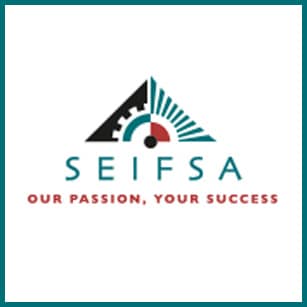SEIFSA WELCOMES PPI DATA IMPROVEMENT, BUT CAUTIONS AGAINST VOLATILE RAND
JOHANNESBURG, 27 OCTOBER 2017 – The increase in producer prices in September 2017 provides some much-needed comfort for producers, the Steel and Engineering Industries Federation of Southern Africa (SEIFSA) said today.
Commenting on the latest data on Producer Price Index (PPI) for intermediate manufactured goods released by Statistics South Africa, SEIFSA Economist Marique Kruger said the industry can be encouraged by the latest data, which show the PPI for intermediate goods remaining in an expansionary terrain for three consecutive months.
“This indicates a continued improvement in factory gate prices and operating business conditions in the metals and engineering (M&E)
sector. The data provide some relief for producers in the sector, who are beginning to derive the benefit of a modest recovery in domestic demand and declining costs,” Ms Kruger said.
She said this was consistent with SEIFSA’s input cost index which decreased to 0.9 percent in September 2017, when compared to 1.7
percent recorded in August. She said the improvement in the latest PPI data was generally in line with an increase in the broader PPI for final manufactured goods, which recorded an annual change of 5.2% in September 2017, compared with 4.2% in August 2017.
The Statistics South Africa data showed that the PPI for intermediate manufactured goods rose to 2.1 percent in September 2017, up from 2
percent in August.
Ms Kruger said that this was encouraging when viewed “against the backdrop of Finance Minister Malusi Gigaba’s bleak news in his Medium-Term Budget Policy Statement (MTBPS) yesterday, which highlighted a tight economic environment characterised by poor tax
efforts and tax morale, expanding government expenditure, ballooning deficits and high debt levels”.
However, Ms Kruger cautioned that although the PPI for intermediate goods in the M&E sector provides a glimmer of hope, economic activity within the sector and broader manufacturing will remain constrained by depressed business and consumer confidence levels that have been linked to perceived policy uncertainty and political turmoil. She said these will definitely keep producer prices volatile in the near term, thus making it very difficult for businesses to plan in advance and contain costs.
Ms Kruger expressed “grave concern” about the latest economic and political developments, which have the potential to quickly reverse the
positive growth trajectory recorded in the second quarter of 2017.
“In an atmosphere of generally low business and consumer confidence, low domestic demand, structural challenges and political uncertainty, the Finance Minister’s bleak news from yesterday’s speech raised more questions than providing answers,” she said.
Ms Kruger also raised disquiet about the oscillating rand’s effect on the economy, saying that a depreciating rand would be less beneficial for inflation, imported input costs and margins of companies in the M&E sector.
“The M&E sector is relatively small and open, hence volatility in price trends and the variables that impact the price trends does not augur well for it. A positive differential in the selling price inflation and input cost inflation needs to be maintained in order for the sector to stay attractive for existing and new investments,” Ms Kruger argued.
ENDS
Issued by:
Jackie Molose
Marketing, Sales and Communications Executive
Tel: (011) 298 9411 and 082 602 1725
Email: jackie@seifsa.co.za
Web: www.seifsa.co.za
SEIFSA is a National Federation representing 23 independent employer Associations in the metals and engineering industries, with a combined membership of 1600 companies employing around 200 000 employees. The Federation was formed in 1943 and its member companies range from giantsteel-making corporations to micro-enterprises employing few than 50 people.
SEIFSA STRONGLY OPPOSED TO ESKOM’S PROPOSED ELECTRICITY TARIFF HIKE
JOHANNESBURG, 26 OCTOBER 2017 – The Steel and Engineering Industries Federation of Southern Africa (SEIFSA) has expressed strong opposition to Eskom’s application to the National Energy Regulator of South Africa (NERSA), saying such an adjustment would cause great harm to the metals and engineering sector.
In a submission to NERSA, SEIFSA Chief Economist Michael Ade said the metals and engineering sector is still struggling to meet the high pre-crisis demand levels attained in 2007, with recovery in production having been modest at best.
“If the tariff increase application goes through, it will be a critical setback for the sector’s productivity. The sector exports 40 percent of its production and international competitiveness is vital for its survival. An inevitable consequence of the proposed 19.9 percent hike by Eskom will be more loss of jobs,” said Dr Ade.
He said that high electricity tariffs add to production costs, a situation simultaneously accompanied by the declining average change in selling prices received by local producers, and squeezes profit margins. He said that although production had just recently picked up in the sector, domestic demand conditions are still tough.
Dr Ade cautioned that excessive electricity tariff increases will eventually stifle Eskom’s supply in the long term as large energy-intensive sectors progressively cut down on demand and install their own powerful diesel generators to mitigate costs.
He said that, in the event that NERSA felt that an electricity tariff increase was necessary, then such an adjustment would have to be “at a much lower percentage that has been requested”.
Dr Ade said the metals and engineering sector’s share in manufacturing output is nearly 30 percent and it contributes to approximately 3.6 percent of the country’s gross domestic product. He added that last year the sector employed around 480 000 people directly.
ENDS
Issued by:
Jackie Molose
Marketing, Sales and Communications Executive
Tel: (011) 298 9411 and 082 602 1725
Email: jackie@seifsa.co.za
Web: www.seifsa.co.za


